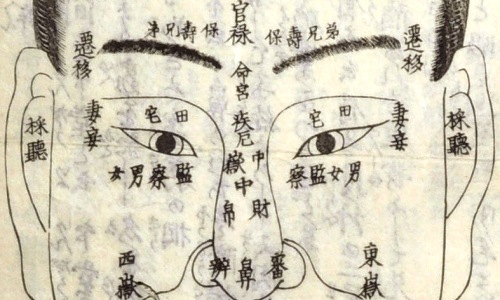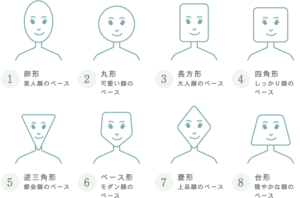Japanese Physiognomy – the Art of Face Reading
Japanese Physiognomy – the Art of Face Reading. Would you like to know what your face says about you, or your relatives, friends, or just anyone else you have never met before? Let’s consult Japanese Physiognomy – the Art of Face Reading.

Contents
Introduction to Japanese Physiognomy – the Art of Face Reading (人相学):
For those who totally disbelieve Japanese Physiognomy – the Art of Face Reading, we don’t try to persuade, but rather provide you with a new viewpoint on Japanese culture: although not widely recognized as a serious science, physiognomy, as an art, holds considerable cultural values. Physiognomy – a crystallization of keen observations, deep reasoning and empirical evidence on human nature – clearly shows how Japanese interpret others, what they believe to be true, and what they value in a person.
Unlike Chinese physiognomy, which aims to guess a person’s fate that may be met in the future, Japanese physiognomy focuses more on drawing a person’s disposition, personality and capability, and guessing what the person has experienced. In face reading, the basic points include face shape, eyebrows, eyes, nose, mouth and ear.
1. Japanese face shape – 面形:
In Japanese physiognomy, there are five basic face shapes: Oval (卵形), Triangle (三角), Trapezoid (台形), Square (四角形 or 田字) and Round (丸い).

a. Oval Face (卵形):
An oval face has forehead of the same width as chin. An oval face is an indicator of nobility: most Japanese kings and officers possess such face shape. People with oval faces are wise, shrewd and emotionally balanced. They are prudent and intelligent. According to expert, people with oval faces have a knack for organizing and hold great ambitions.
b. (inverted-) Triangular Face (逆三角):
A triangular face has high and broad forehead, hollow cheeks but prominent cheekbones, bony small nose, hollow eyes, and protruding narrowed chin. People with triangular faces – men or women – are excessively sensitive and emotional. They are either intelligent or crafty people who hardly get on well with others. The triangular-faced also dislike ties with anybody and lack fidelity and loyalty. Experts observe that spies and traitors usually possess triangular faces.
c. (inverted-) Trapezoidal Face (逆台形):
A trapezoidal face is somewhat similar to a triangular: it has high, broad forehead and narrowing (but not pointed) chin. It is typical of scholars and artists, but untypical of warriors. Women with trapezoidal face are excessively optimistic: they live happily and create around them a comfortable and cozy atmosphere.
d. Square Face (四角形 or 田字):
People with square faces are usually strict, courageous and even hard-hearted. Japanese believe the square-faced are quite obtuse and stubborn. On the bright side, they are resolute and determined. In treating people, they are open and outspoken. Most of the square-faced persistently cherish great ambitions. They are unapproachable duty performers, although they may endeavor to reach leadership. Japanese men think women with square faces may seize domestic power and eclipse their husbands.
e. Round Face (丸形):
Japanese associate a round face with benevolence, flexibility and geniality. People with round faces are gourmets and hedonists, enjoying a convenient life with their peers, rather than vanity. They would never hurt their pride over minor things. A combo of round face, long nose, prominent cheeks and bright eyes indicates a visionary person. According to Japanese physiognomists, great leaders and generals usually possess the combo.
2. Eyebrows (眉毛):
Eyebrows reveal temperament and emotions.
An ideal pair of eyebrows is broad, long, and harmonious in shape, color and density, which indicates balance between sense and sensibility. Stiff brushy eyebrows may prove the contrary.
Japanese think men with long and delicate eyebrows are erudite, whereas women with the same eyebrows are over-sprucing and foxy.
A thick set of eyebrows slanted upward signifies valor and generosity. In contrast, eyebrows slanted downward suggest reticence. Short, thick eyebrows suggest short temper. Shaggy eyebrows (like a broom) signify either duplicity or stubbornness. People with heavy eyebrows drawing together near the nose can be imperious and dictatorial.
Quick tip: The farther the eyebrows are from the eyes, the more visionary the subject is.
3. Eyes (目元):
Japanese physiognomists agree that people with sparkling and lively eyes are healthy, intelligent, persistent and ardent. Without spirit glaring from the eyes, the subject may lack health or charisma.
People with large eyes are usually acute, valorous, outgoing and ambitious. Small eyes are found at introvert and complacent people. Large iris reflects geniality and calmness. Small iris is a sign of emotional imbalance. Iris colors count, too:
+ Black (黑色), brown (茶色), green (緑色): passionate, resolute
+ Blue (青色): sensitive
+ Light brown (狐色): shy
Japanese also categorize eyes based on shape. The shapes derive from those of animals’ eyes.

– Dragon eyes: large, sparkle, bright, glaring prowess. Those endowed with dragon eyes are powerful and influential.
– Phoenix eyes: long, having slanted and deep canthi (eye “tails”), signify acuteness, delicacy, skillfulness and talents.
– Lion eyes: large, having folds alongside the eyelids, suggest good leadership.
– Elephant eyes: small, having many folds alongside eyelids. Elephants eyes often belong to fat guys and suggest calmness.
– Tiger eyes: large, rounded, sparkling with golden light. The tiger-eyed are exceptionally talented and resilient, but may have erratic temper.
-…
There are about 40 more eye shapes, all named after animals. Japanese believe that people with the eyes of what animal, have the traits of that animal.
4. Nose (鼻):
An ideal nose has full rounded point and balanced sides. Those endowed with the ideal nose are like lions, courageous and enthusiastic.
A long nose proves strong personality if it matches eyes and mouth well. However, a long but bony nose suggests haughtiness. A long but convex nose shows cantankerousness, while a concave one may show uneasiness.
People with a nose similar to a drop of water are optimistic and enthusiastic, thus may succeed in their career. Those with up-turned noses are dissolute and self-indulgent.
Quick tip: alcoholics often end up having rough orange-like nose skin.
5. Mouth (口):
The shape and size of the mouth can reveal how much will and perseverance a person has.
Wide mouth indicates courage, small mouth the contrary. Japanese prefer men with wide mouths and women with small delicate ones.
If the mouth turns into a mere line when tightened, it suggests that the person is too cautious and meticulous.
A mouth convulsing from time to time, he may be suffering from neurosis (neuronal dysfunction).
6. Ears (耳):
* Ear position:
– Higher than eyebrows: exceptional mental ability
– Of the same height with eyebrows: medium mental ability
– Lower than eyebrows: lower or medium mental ability
* Ear lobe:
– Too long: indifferent
– Small and bent inward: too cautious and meticulous
– Large: sage and kind-hearted (Buddha has noticeably large ear lobes)
* Additional Notes:
– In practice, to ensure preciseness, Japanese physiognomists try to get to know the subject’s age, because with age complete traits.
– Traits that are surgically altered may provide false information.
Now you learn about Japanese Physiognomy – the Art of Face Reading. Anyway, beside physical traits, Japanese physiognomists also base judges on manners and speech of the subject. Likewise, we should also not judge someone merely on their appearance.
To learn more about Japanese Culture, access: Japanese Culture
tu hoc tieng Nhat – Johahn Stillmann


